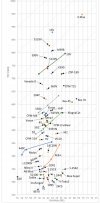- Joined
- Jul 2, 2009
- Messages
- 1,176
Hey all – recently I posted a thread in the general section asking how tuff 420hc is in general. That thread got shut down (I believe because some people were giving somebody who posted a generic steel chart a hard time) shortly after the thread was started. Regardless I would like to continue the discussion here specific to Bucks 420hc toughness. During that thread someone posted a steel chart made by Larrin who seems to be well respected on the forums. His steel chart not only identifies 420hc as tuff – it looks ridiculously tuff. If I am looking at these charts correctly at 57-58 / 420hc looks to be nearly 3v tuff and way tougher than something like 1095 or A2. Is this correct? And if so why is this not more broadly marketed as a key attribute of 420hc?








 on 420hc when it appears 420hc is tougher and stainless.
on 420hc when it appears 420hc is tougher and stainless.
